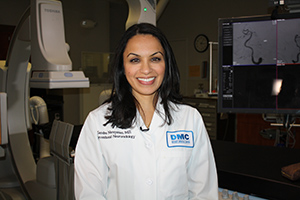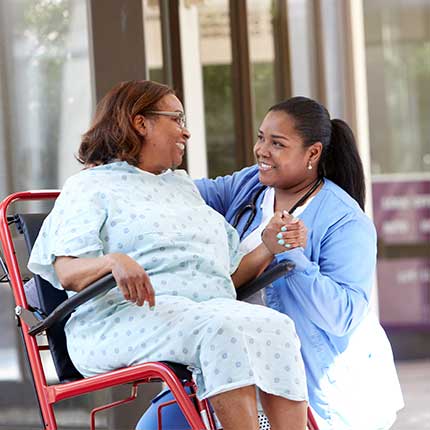The right ED Team and stroke diagnosis help a patient beat the odds
May 16, 2017A stroke occurs when blood flow to a part of your brain is stopped either by a clot (ischemic stroke) or the rupture of a blood vessel (hemorrhagic stroke). Patients who receive clotbusters or mechanical clot retrieval within 3-4.5 hours of their first symptoms tend to have better survival rates and fewer long-term complications that those who receive delayed care. So, what was the outcome
 |
| Dr. Sandra Narayanan, shown standing in front of the Toshiba biplane at Sinai-Grace, is the Director of the Neuroendovascular Program for Detroit Medical Center. |
for a patient who arrived to the Sinai-Grace emergency department outside of that critical 4.5-hour window with a clot? Remarkably, he survived with no long-term disability due to expedient Emergency and Neuro-interventional Teams and advanced technologies available at DMC Sinai-Grace Hospital located in Northwest Detroit.
The 37-year-old Detroit man was transported by EMS to the DMC Sinai-Grace Emergency Department in January earlier this year. He had left-sided weakness, facial droop, and the inability to speak, according to reports from his attending Emergency Team. The patient was also having various vision symptoms and headache. He was quickly transported to radiology for a CT Scan to get images of his neck and head. The ED team confirmed he had suffered an ischemic stroke. “He was several hours beyond the time when they could use tPA therapy [tPA is a common drug treatment used in emergency treatment of strokes and heart attacks],” recalled Dr. Sandra Narayanan, the DMC interventional neurologist called in to operate on the man. The emergency was made more complicated because it was a “posterior circulation stroke” affecting the brain, thalamus, and occipital lobes. “This type of blockage carries a 90% mortality rate. Over 90% of patients with a vertebrobasilar occlusion will die if the artery is not opened in time,” she added.
To avoid nerve cell death and severe brain injury, it was critical for Dr. Narayanan to quickly open the artery that supplied oxygen-rich blood to the back of the brain in a procedure known as a mechanical thrombectomy. The technology that allowed her to perform the life-saving thrombectomy was the Toshiba biplane machine located in the Sinai-Grace cath lab. With the biplane, Dr. Narayanan was able to mechanically pull out the blood clot using a stentretriever, a stent-like device that can snare the clot to open up a channel of blood flow. “He had a complete blockage of the left vertebral and basilar arteries” stated Dr. Narayanan. But, she opened the artery and he thrived. “The NIH Stroke Scale was seventeen at the start of the procedure and he literally went to zero by the end of the procedure. He was discharged four days later with no significant disability and went home,” stated Dr. Narayanan
Strokes due to impaired blood flow to the back of the brain are not as easily caught and account for only about 20% of all ischemic strokes, according to Dr. Narayanan. “Stroke is not a painful disease; it’s unusual to have a headache so it doesn’t prompt people to call 911 unfortunately,” said Dr. Narayanan. Symptoms of this type of stroke include double vision or loss of vision, unsteadiness, talking as if intoxicated, facial droop, weakness on one or both sides, lethargy, and respiration changes. Sometimes a person will become comatose, so emergency medical personnel may initially diagnose it as a drug overdose, Dr. Narayanan noted. Alcohol intoxication was considered as a possible diagnosis in this patient due to his history of alcohol abuse.
There are many factors that can add up to surviving a stroke like this 37-year-old, including age, blood pressure, EMS arrival, and early recognition of symptoms,” explained Dr. Narayanan, “but every minute counts.” The quick diagnosis and treatment by the Sinai-Grace Emergency medical team, which also included Emergency Medicine physician Marc-Anthony Velilla, prevented the Detroit man from having any long-term deficits. “Stroke is very common and serious, so it’s important to know the symptoms, to call 911, and to receive lifesaving treatments,” stated Dr. Narayanan.



